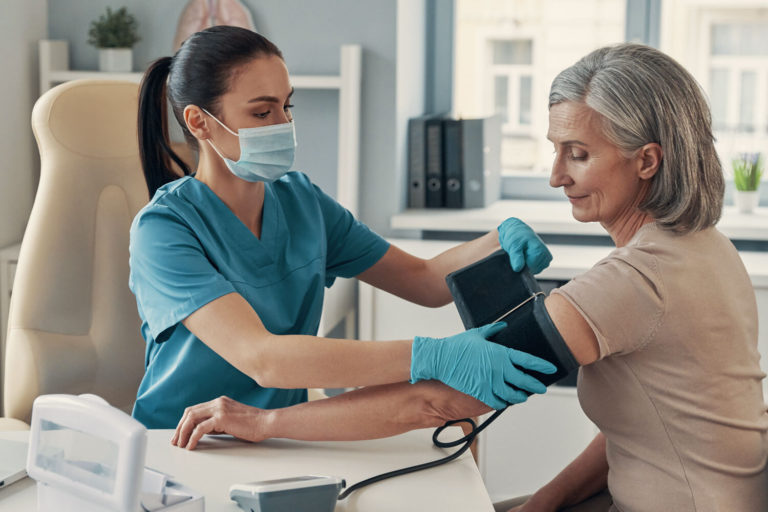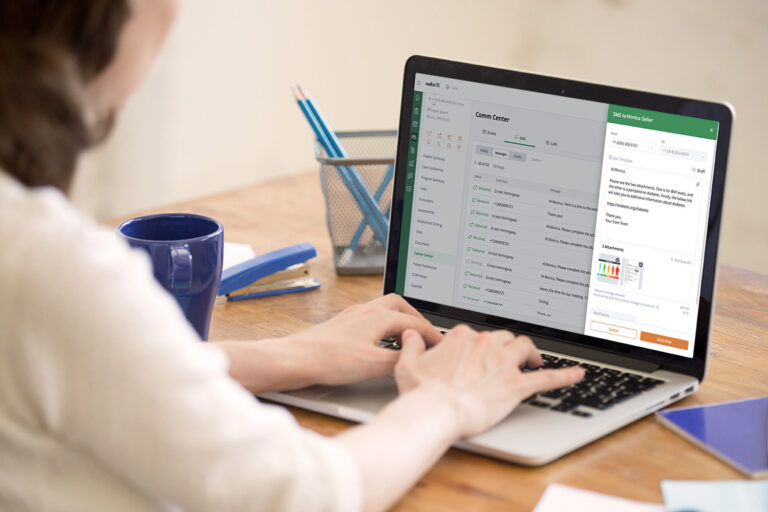The COVID-19 pandemic has demonstrated the mental health benefits of patient monitoring — for patients and healthcare providers alike. This invaluable telehealth tool has provided a convenient, customizable health data solution for chronic disease management that enables social distancing while reducing administrative workload. When they can focus on care plans instead of patient data processing, clinicians can improve health outcomes for their patients while reducing their own burnout risk.
According to the National Institutes of Health, approximately 1 in 3 physicians is experiencing burnout at any given time, endangering their wellbeing as well as the quality of healthcare delivery. How can remote patient monitoring (RPM) help? This digital technology uses medical devices to secure health data from patients at any location and electronically transmits it to healthcare providers. By tracking patients’ vital signs, RPM devices — like pulse oximeters, blood pressure cuffs, or remote electrocardiograms (ECGs) — allow a care team to decide in real-time when chronic conditions like congestive heart failure, diabetes, or dementia require intervention.
Healthcare providers used to schedule regular office visits to monitor biometrics like heart rate, blood pressure, cognitive function, blood glucose levels, and vitamin deficiencies for patients with chronic conditions. These frequent visits can be stressful for both patients and providers, increasing cancellations and decreasing compliance.
When they can regularly monitor the health information of high-risk patients from afar, healthcare providers can keep chronic disease management out of the emergency department and their own stress to a minimum. More effective Care Management can lead to greater patient engagement and health outcomes, alleviating burnout.
What are the signs of healthcare provider burnout?
Healthcare provider burnout is a work-related stress syndrome characterized by chronic job stress and decreased job fulfillment — especially while treating high-risk patients. Chronic disease management and intense emergency department injuries can affect the health outcomes of not only patients but also their overworked and anxious healthcare providers.
The term “burnout” was introduced in the early 1970s by psychoanalyst Herbert Freudenberger, who observed that it consists of emotional exhaustion, cynicism, and depersonalization, as well as reduced professional efficacy and personal accomplishment. Consequences of burnout are decreased job satisfaction, absenteeism, turnover, and cynicism with repercussions on healthcare professionals’ personal life (unhappiness, anxiety, depression, isolation, substance abuse, frictional and broken relationships, and divorce).
Healthcare Business Today reports that the onset of the pandemic, the risk of burnout, and insufficient sleep have surged among healthcare providers and caregivers. A recent study published in the Journal of Diabetes and Metabolic Disorders revealed that a considerable percentage of medical staff experienced high-risk levels of anxiety and depression during COVID-19 — especially nurses and front-line healthcare workers in areas with high infection rates.
Healthcare provider burnout has been linked to suboptimal patient outcomes, lower patient satisfaction, and errors in healthcare delivery that may lead to malpractice suits and litigation with substantial costs for healthcare systems. Common sources of stress for healthcare professionals include:
- Inefficient Care Management
- Insufficient patient compliance
- Excessive hospital readmissions
Let’s examine how remote patient monitoring can help relieve the burden of each stressor.
How remote patient monitoring relieves care plan stress
Stress exacerbates most chronic and acute conditions. Achieving optimal health outcomes is difficult when both patients and clinicians are forced to take extra steps and perform extraneous administrative tasks. Without streamlined workflows and centralized communication, care plans cannot be efficiently implemented, exacerbating clinician stress.
Patient-generated data offers valuable insights that care providers wouldn’t otherwise have access to — that means they have more tools to tap when assessing, diagnosing, and prescribing care. Collecting more critical health information helps clinicians achieve better health outcomes. They also find that patient monitoring systems allow them to streamline or bypass certain administrative and service tasks.
Remote vital sign monitoring solutions allow healthcare providers to leverage AI to read vital signs such as heart rate, blood oxygen, or respiration rate, which are associated with a higher likelihood of COVID-19 infection. This real-time patient information can help healthcare professionals triage people remotely and decide whether they should seek further medical attention or reduce the risk of exposure by remaining at home.
Whether it’s oxygen levels, heart rate, or COPD symptoms, RPM services enable customized, secure Care Management via smartphones and wearable medical devices. When healthcare providers can reduce the stress of overbooked physical appointments, they can assist more patients per day, enjoying higher job satisfaction and lowered stress.
Continuously analyzing health data and improving patient care via telemedicine and customized monitoring programs helps expand healthcare access to patient care in communities and regions with few health systems. Responding to phone calls on mobile devices is much easier than scheduling and performing office visit exams. Supporting Care Management strategies with remote patient monitoring makes care delivery workflows more efficient and less exhausting.
How remote patient monitoring helps improve patient compliance
The Pew Research Center reports that 92% of American adults now have a smartphone — so many prefer sending digital health information to their provider at a convenient time and place. They appreciate not having to disrupt their routines and schedules with frequent follow-up visits.
When patients are able to collect their own data from wearables and other remote patient monitoring devices, they play a more active role in their care and participate in decision-making.
In fact, HIMSS found that 60% of patients feel more engaged and empowered to manage their condition when they discuss self-generated health data with their providers. Decreasing the number of office visits enables clinicians to dedicate more time and attention to monitoring and educating their most at-risk patients with chronic diseases.
According to Million Hearts, one-third of deaths in the U.S. are caused by heart disease. The CDC reports that 34 million Americans are living with diabetes and another 88 million are diagnosed with pre-diabetes. The Asthma and Allergy Foundation of America estimates the annual direct costs of asthma in the United States is $50.1 billion (mostly for hospital stays).
Remote patient monitoring enables clinicians to consistently collect biometric data and see what a patient is or isn’t doing, then provide more education on their condition digitally. When they can observe and track vital signs to monitor chronic conditions like hypertension, heart failure, diabetes, COPD, asthma, dementia, and mental health disorders, healthcare providers can intervene in a timely manner using medical devices like:
- Smartwatches: can be customized to become a dedicated RPM device with sensors that gather biometric data and transmit it to the clinician’s platform
- Patch-based sensors: RPM devices that continuously gather biometric data — from electrocardiogram and heart rate to body posture and activity levels— and stream data to a patient’s smartphone as well as a clinician’s platform
- Bluetooth biometric devices: customized RPM devices that connect tablets to Bluetooth-enabled biometric devices like pulse oximeters, blood pressure cuffs, weight scales, and glucometers
Effective and consistent patient monitoring expands the efficacy of Care Management — a critical care plan compliance tool — and nurtures patient-provider relationships. The more clinicians can trust patients to understand their own chronic conditions and treatments, the less stress they’ll experience. Patient monitoring promotes patient engagement, which can lead to better health outcomes and patient satisfaction. And satisfied patients tend to make for more fulfilled healthcare providers.
How patient monitoring can help reduce hospital readmissions
The Kaiser Family Foundation reports that in 2020, readmissions cost U.S. hospitals $563 million. High readmission rates exacerbate care team stress and cause their healthcare organizations to lose Medicare reimbursements. Hospitals and home health organizations that prioritized reducing readmissions were early adopters of RPM devices, so they’ve had time to research the efficacy of their efforts. Here are some examples:
- A study conducted by Preventice found a smartwatch could reduce a significant percentage of unnecessary emergency room visits and outpatient visits.
- A Christus Health clinical trial found that patient monitoring helped reduce hospital readmissions by 65% among congestive heart failure patients.
- A year-long study published in mHealthIntelligence credited remote patient monitoring with reducing hospitalizations by more than 30%.
Telemedicine and patient monitoring programs have helped reduce workloads, decreasing COVID-19 transmission risk by reducing emergency department and ICU traffic. Healthcare providers who leverage remote patient monitoring are able to care for more patients. When specialists and primary care teams centralize their RPM data communications, they can streamline workflows and relieve burnout.
RPM devices securely transmit patient data to a third-party HIPAA-compliant RPM platform that analyzes data and delivers it to clinicians via user-friendly dashboards, enabling them to detect concerning trends in real-time and intervene before a patient requires hospitalization. Nurses or physician assistants are able to monitor patients until they notice a trend that requires clinician intervention to decide on treatment adjustments. Functioning at the top of their licensure allows clinicians to enjoy their specialties and relieve burnout from administrative tasks.
Help relieve burnout for your care team
Don’t let burnout get the best of dedicated clinicians and administrators. Leverage telemedicine and remote patient monitoring to streamline workflows, relieve anxiety, bolster patient-provider relationships, and improve job satisfaction. Learn how telehealth and remote patient monitoring can enable them all to enjoy the fulfillment they envisioned when they entered the healthcare industry — read our Definitive Guide to Remote Patient Monitoring.


